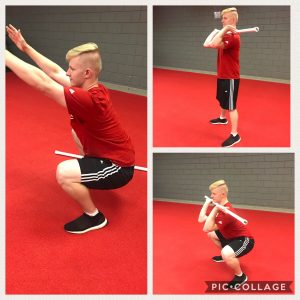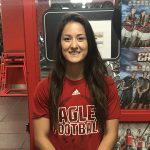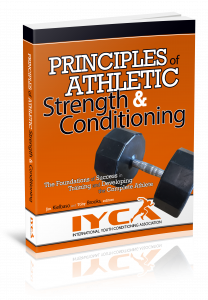Multiple-sport athletes in the high school setting are extremely common. However, coaches may find it hard to create a training program that can cater to the various requirements each sport demands.
As strength and conditioning professionals, our job is to create a comprehensive training program for these athletes. The goal is to build their baseline of training, make them fundamentally sound and progress their movement throughout their program. Multi-sport athletes should be able to learn their weaknesses, balance them out structurally and exercise different degrees of motion to become a better overall athlete. These concepts are key when creating a program that will increase performance but also decrease the likelihood of injury.
Getting Started
As you get started with a new, multi-sport athlete, ask these questions:
What have you done to train in the past? What sports do you play? Have you ever worked with another strength and conditioning professional/had any formal training outside of your sport?
No matter the age of the athlete, it is important to consider the training age of the individual that you are working with to help you gauge the intensity of the program. More often than not, the high school athlete has limited resistance training experience, speed and acceleration work or conditioning anywhere outside of their school sport coach.
Asking what sports they play can help you understand the demands that are being placed on them and the types of movement preparation or accessory exercises you may want to incorporate into their training program.
What injuries or structural issues have you had in the past?
Many athletes have experienced some sort of pain or injury throughout their young career and need help regaining strength or motion, so it is important to create programs that will aid in resilience. Having a complete knowledge of their injury history allows you to prepare for specific imbalances or overcompensations that we can help fix.
What are some things you would like to improve?
Try to have the athlete get specific. Drill down by asking follow-up questions like “Are their plays you feel like you can’t make that you’d like to be able to next season?” Depending on their goals, they may want to focus on gaining greater performance in specific areas and you must create a program that can cater to those needs.
If they’ve trained in the past, what kinds of training have they enjoyed/hated in the past?
Incorporating their interests is a great way to engage and empower an athlete. If they have had no formal training, ask what types of things they enjoy doing in their sports practices or have a list of ideas ready to discuss with them to gain a better idea of what they like.
How often can they train with you each week? What is their practice schedule?
This will help you know how long you will be training with them, what your program goals can be and how to program around the demands of their practice schedule. Athletes often forget how much they’re doing outside of training and don’t understand how it all affects their results. As a professional, you’ll have to explain this to them and help them balance all of their competing demands.
Assessment
Before starting any training program, you’ll want to have an assessment session to help you parse out any glaring concerns. You can not build a program for an individual before you have watched them move and observed their limitations. This can be a formal assessment or simply an observation during a dynamic warm-up. Here are some things you can do to see how the individual moves:
Take them through a basic dynamic warm up:
High Knees, Butt Kickers ,High Knee Hugs, Pendulums, Quad Stretch and Reach, Runners, Lateral Lunge and Pivot, Figure 4 + Air Squat, Carioca, Skips, Backward Run, Side Shuffle, 2 10 yard sprints
Watching an individual move through a dynamic warm-up can help you spot imbalances or movement deficiencies immediately.
Squat Assessment: Air Squat, PVC Front Squat, Back Squat, Overhead Squat


Press Assessment: PVC Overhead Press
Lunges: Lunge in place, forward lunge, backward lunge, side lunge
Mobility/Flexibility: Ankles, Hamstrings, Hip Flexors, Back, Shoulders
These are just a few exercises that can be used to spot imbalances/deficiencies before you start a training program. Understanding their needs and limitations will help you create a program that will build a better athlete.
Start Programming!
Once you have all of the things you need to know about your athlete, you can start programming. Considering that the individual has most likely never trained outside of their sport, we need to build up their base of strength, mobility, stability, speed, change of direction and conditioning. Because you’ll probably have very limited time with a multi-sport athlete, keeping introductory programming simple and straightforward is the most effective way to make progress. If you plan on working with this athlete throughout the year, you’ll want to keep the volume relatively low so they can make progress without creating unnecessary fatigue.

The goal should be to elicit a training response without compromising their performance. This can be tricky, so you’ll want to have an open line of communication regarding their competition and practice schedule. Working them extremely hard right before an important competition can ruin their performance and possibly set them up for injury. Instead, you’ll want to time the training sessions in a way that doesn’t overly interfere with important events. For example, if games are played on Tuesday and Friday, training sessions would probably take place on Wednesday and Saturday so there is ample time to recover before the next competition. Not only will this help the athlete, it will keep you in good graces with the sport coach.
It’s especially important to balance the fatigue of areas that are used heavily in a sport. For example, you don’t want to use high-volume lower body training on an in-season track or soccer athlete who is running every day. Similarly, you don’t want to get a baseball pitcher’s upper body sore/fatigued when they have to throw a lot the next day.
Dynamic Warm up: Get their blood flowing. Whether or not they are currently in season for a specific sport will change the way you approach the dynamic warm up. You can make it extremely basic or add elements that relate specifically to the sport they are currently playing.
Movement Prep: Use belly breathing, flow progressions and stretch variations that move through a range of motion focusing on structural imbalances, glute activation and activation of specific muscle groups desired. Pick specific exercises that the individual can work on to increase their range of motion in troubled areas. Your assessment will reveal these areas and allow you to pick the most important exercises for each athlete. There are a million exercises to choose from, but you need to be extremely efficient with multi-sport athletes because they don’t have a lot of extra time and energy for training. Address the “big rocks” first by picking the exercises that are most important.
Speed/Change of Direction: Footwork of any sort is always beneficial. Incorporating reaction drills, line drills and change of direction/acceleration drills can help prime the nervous system for training. Communicate with the athlete and/or coach to ensure you’re not doubling up on drills that may be done during practice. For example, a soccer coach may do a bunch of sprint work in practice. If that “box is checked,” don’t spend as much time on linear speed work. Instead, you may want to include more agility or reactionary work.
Resistance Training Elements: Hinge, squat, push, pull and core are simple highlights of a training program that can be done easily and efficiently. You can use dumbbells, medicine balls, kettlebells and resistance bands to build up strength before loading an athlete with a barbell. Examples include:
Hinge: Power Exercises, Kettlebell Swings, Trap Bar Deadlift
Squat: Squats, Lunges, Single Leg Variations
Push: Overhead Presses, Bench
Pull: Row, Pulls, DL
Core: Pick exercises such as anti-rotational, core Stability, anti-extension core work.
Assistance Exercises: Include any-sport specific exercises each season that you would like to work on or movement correctives that you see fit for the individual. Fixing imbalances and utilizing smaller muscle groups can help achieve correct functional movement.
The goal of resistance training for multi-sport athletes is to focus on building up the overall strength/athleticism, not building up a sport-specific athlete. Focus on joint stability and mobility through different exercises without creating unnecessary fatigue. You’ll want to stick with moderately heavy weight, but not take sets to failure very often. An example would be using 80-85% of a 1RM for just 3-4 reps. Not all exercises need to be done with heavy weight, but using a relatively high intensity with low rep ranges allows the athlete to maintain or improve strength without creating excessive fatigue. Higher-rep lower body training, for example, can cause excess fatigue that may be great in the off-season, but can over-tax an athlete during a season.
Simple plyometric exercises: Hops, bounds, skips, pogo jumps, jump to stick, squat jumps, single leg variations, vertical jumps, medicine ball throws and tosses.
Conditioning (if necessary and time allowing): Depending on the time you have with your athlete in a training session, conditioning may or may not be a priority. Challenging your athlete with various types of conditioning that they have not been exposed to is a way to train them differently, build up their work capacity and can be a great finish to a training session.
Mixing up the Training Stimulus
Try to stay away from solely using barbells and dumbbells for every exercise. For example, instead of a walking lunge using a kettlebell in a goblet carry or various carry, try a medicine ball held to the chest, or in a different position, or using a weighted vest. Changing it up can also be beneficial when working with younger athletes because it keeps them interested and focused on the task when it’s something they haven’t done before. The body doesn’t care if it’s a 15 lb medicine ball vs a 15 lb weight vest, but this can keep an athlete engaged in the training because it’s interesting.
Key Notes When Training the Multi-Sport Youth Athlete
• Build up the athlete as a whole from the bottom up, build a sound-moving body, not necessarily a better football, softball, baseball, soccer player.
• Find movement or muscular imbalances that you can fix that will help them perform better in all of their sports
• Mix it up often, using various training stimuli to better train the overall movement
• Teach them to move through a full range of motion and slow things down to emphasize proper musculature firing and technique.
• Proper core stability and firing, joint stability and strength are important when it comes to injury reduction and should be highlighted in every program
• Teach healthy recovery protocols early on
• Create enough stress to stimulate adaptation without inducing unnecessary fatigue
Allowing athletes to play multiple sports is a great way to prevent overuse injuries, but training them to become better all-around athletes can be the best way to produce long-term health and success.
 Jordan Tingman – CSCS*, USAW L1, ACE CPT, CFL1 is a graduate of Washington State University with a B.S. in Sports Science with a Minor in Strength and Conditioning. She completed internships with the strength & conditioning programs at both Washington State University and Ohio State University, and is currently a Graduate Assistant S & C Coach at Eastern Washington University.
Jordan Tingman – CSCS*, USAW L1, ACE CPT, CFL1 is a graduate of Washington State University with a B.S. in Sports Science with a Minor in Strength and Conditioning. She completed internships with the strength & conditioning programs at both Washington State University and Ohio State University, and is currently a Graduate Assistant S & C Coach at Eastern Washington University.
The IYCA’s Principles of Athletic Strength & Conditioning textbook covers how to train the multi-sport athlete in great depth as well as many other topics related to developing athletes. The PASC book includes contributions from 17 top professionals including college, high school and professional-level coaches. Click on the image below to learn more:



